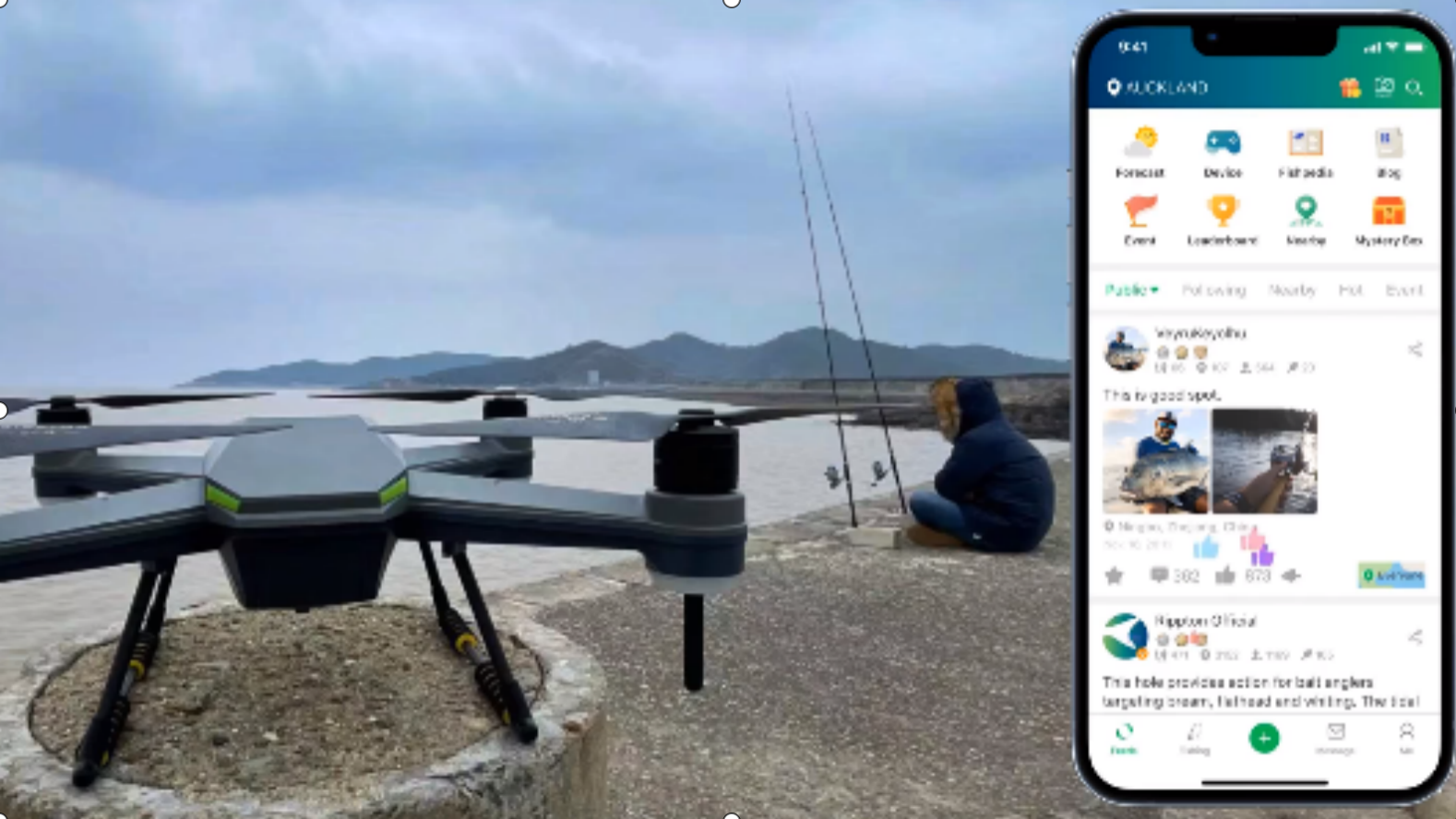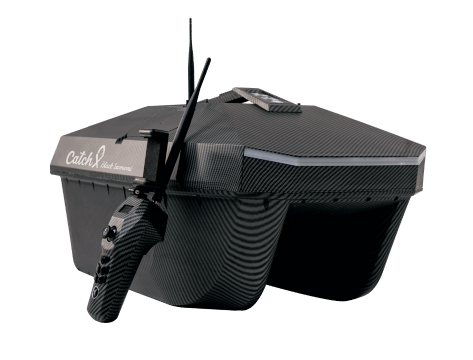How to Go Surf Fishing
A while back, I wrote an article on how to plan a surf fishing session which covered things like conditions, peak seasons, and what I bring, but now, I’d like to cover how to go surf fishing. This article will be focusing on what goes into catching fish in the surf and everything that goes down while you’re on the sand. I’ll be writing this as if I were at the beach fishing for myself and also as if I were guiding. So… How to Go Surf Fishing.
After writing this article, I realized how many factors I have come to consider on autopilot, so I apologize if the amount of information (and maybe derailed train of thought) confuses you guys. PLEASE ASK QUESTIONS IF YOU’RE CONFUSED.
A quick note: I’d like to announce that just recently Surf Fishing In So Cal has earned a rating in the top 100 fishing blogs in 2021 by Feedspot. Thee guys search for and accumulate a list of some of the highest quality content out there, so feel free to check them out. At number 15, I couldn’t be more thankful for all the support and engagement from the So Cal surf fishing community as you guys are what have made this accomplishment possible.
Reading the Surf
I’ll be doing a video on this and a subsequent article to pair with it, but when I arrive at a beach, the first thing I do is read the surf. At this point, I’m looking at the water and all present conditions, and comparing them with the predictions I’d seen prior and noting any unpredictables like seaweed, current, etc. I like a rising tide, but in reality, I think it’s more important to fish to the conditions and to fish the structure. Ideally, we’re fishing a spot with low surf, good structure, minimal seaweed, minimal current, and loads of fish!
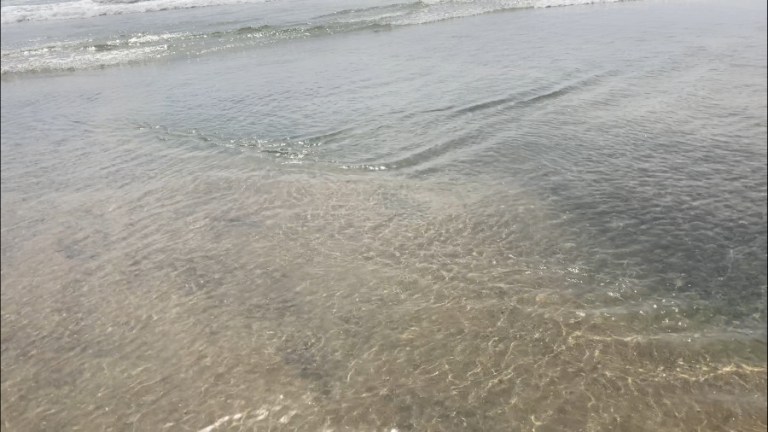
So, I’ll scope out the beach upon arrival, note the overall conditions, and pick a spot where I’d like to begin my session. Depending on the bite, there’s a chance I’ll be fishing the same spot all session long. Many anglers prefer to pack light and stay on the move. I admire this, and I think there’s a time and place for this style, but I very rarely commit to this style.
Other anglers are purely bait and wait style (you see a lot of this on the east coast and in the gulf coast too) and I’m not a huge fan of that, but it can certainly be productive too. I prefer to be actively fishing when it comes to light tackle, but obviously I throw in some bait and wait for sharks.
A few reasons for not packing light here:
If I find a spot that looks good, I like to commit to it for at least a little while. All my best days (in terms of numbers) were the result of having found a really awesome spot that just produced fish all day long or at least high volume for some period of time. It’s also worth mentioning that I usually fish with a buddy, so we have the luxury of one person fishing near our gear while (if the bite is slow) the other can wander up or down the beach looking for a better spot. If we find a better spot, we pack up and move.
I hate fishing with a backpack on. That’s just me. I just can’t fish a whole day like that. Some guys can and props to them, but I don’t even like to keep a phone on me when I fish. Obviously, I’ve started wearing a GoPro every once in a while [NEW VIDEO OUT: Surf Fishing Carlsbad], and that’s not bad since I have a nice chest strap and mount, but I prefer to not be wearing any weight or clunkiness.
I like to have options and fish to the conditions. Come summertime, It’s tough for me to leave the shark gear behind, especially when I know the conditions look solid. So, I like to bring my shark gear, leave it on the beach, and if I need to move, I pack up, carry all my gear to the next spot, and work the heck out of it. Even if I bring light tackle only, I’ll be doing the same thing. Especially because I always pack too much to even think about wearing the entire backpack while fishing.
Gathering Bait
Once we’ve found a good spot, the next step is to gather bait. Now, this is really only applicable to surf fishing in the warmer months. When sand crabs are present (seasonally), I’ll show up to the beach, set my gear down, grab my colander, and start digging for sand crabs. I use a colander to dig sand and sift through it in the water. I find this to be the most effective way to dig for sand crabs. For more on which sand crabs work best (size, hardness, etc.)
If sand crabs aren’t present, I’ll use mussel meat, Fishbites, Lucky Crafts, Super Slayers, and a few other options for backup/off-season baits that are all listed here. With these, I have them prior to the session and we’re ready to get goin’ upon arrival.
Some popular baits that are universal to surf fishing include shrimp, mussels, sand crabs, clams, mackerel, mullet, squid, anchovy, other crabs and cut bait, and plenty more.
Rigging Up Your Rod
Below, I’ll give a quick snapshot of my exact gear and tackle, but here’s a video showing you eaxactly how I rig my rod upwith a Carolina rig. Unless I’m fishing a lure like the Lucky Craft FM 110, I’m rigging up the Carolina rig immediately. It’s my go-to rig and I’d lobby that it’s the go-to for most So Cal surf anglers too.
Some guys like the “high-low”, some like the “texas rig”, and even the “drop shot”, “the 3-way”, and a few others. Whether you’re just learning how to fish the surf, or you’ve known how to go surf fishing for a while now, I recommend trying the Carolina rig if you haven’t yet. I like a 7-9 foot spinning rod with a 4000 series spinning reel, but whatever your personal preference may be, go with it. Additionally, depending on your target, and location, those specs cold drastically change.
Here’s my Set-Up:
- Reel: Penn Battle 4000(II or III).
- Rod: Okuma Celilo Salmon/Steelhead | The St. Croix Salmon/ Steelhead rod is very comparable.
- Other Recommended Rods and Reels.
- Terminal Tackle
- 15 lb monofilament (mainline)
- 1-ounce sliding egg weight
- Protective beads– I actually just use store-bought craft beads most of the time as they have a wider hole.
- Barrel Swivel (size 7)
- 15lb fluorocarbon line (leader line)
- Size#2 mosquito hooks or size#4 mosquito hooks.
- Lucky Craft Lures– for halibut, big perch, and other predators (not used with C rig).
Hot to Go Surf Fishing: Hooking Your Bait
Alright, now that we’ve picked our spot, gathered our bait, and rigged our rods, we’re ready to start fishing the surf. If we’re surf fishing with sand crabs, I like to place the hook first through the shell, and out the belly where the orange roe (eggs) are. I’ll be doing a video on sand crabs and surf fishing this summer, and I’ll make it a point to take a good photo of how I hook them for this article too, but for now, my words will have to do… photo now updated below:
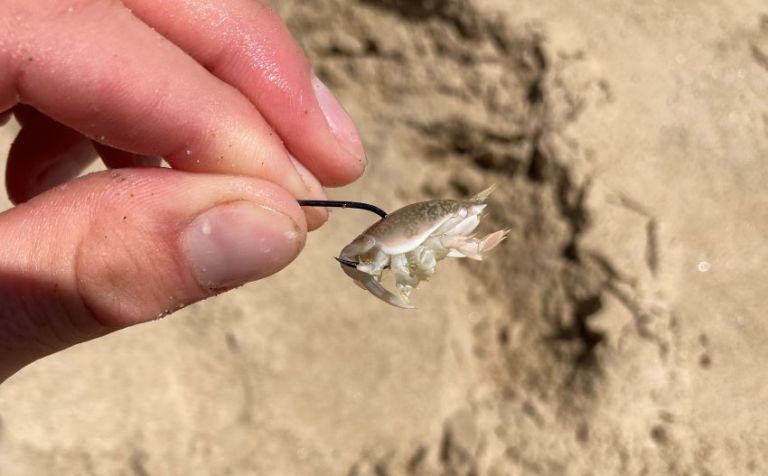
For mussel meat, I already have a video up on how to go surf fishing with musssel meat. I also have a good photo of how I like to hook it as shown below. I really only use mussel meat in the colder months when sand crabs aren’t readily available. Fishbites will be used in the summertime too, but those are very simple to hook… through and through.
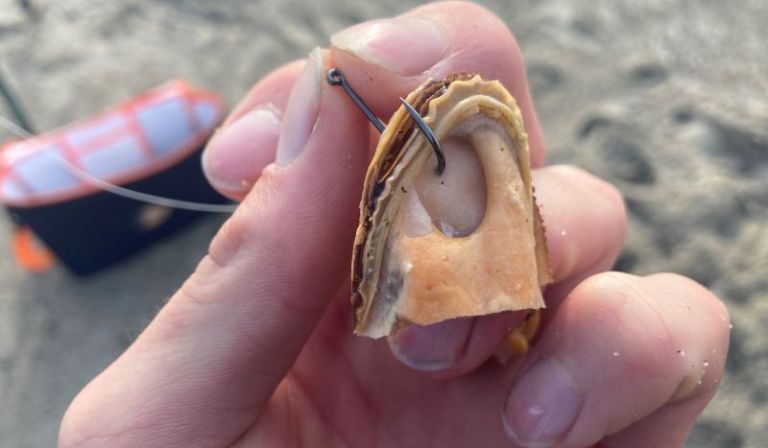
Surf Casting
It’s worth mentioning that no matter how clearly I state my preferences and “rules” I’ll almost always go with my gut, and if my gut tells me to cast in that really flat dead-looking section of the surf, I’m going to do it. There are some things you learn to see in the surf (after some time) that just “look good” to you and you can’t explain why. And as you learn and gain experience, that statement will make a lot more sense.
That said, when you find your structure, do what Bill Varney likes to call “fan casting”. Cast on the far-right side, the middle-right side, the middle, the middle-left, the far-left, and then all of the above short and long. While Bill likes to refer to this as “fan casting”, I refer to this as “working the heck out of a spot”.
10:30 to 1:30 and Fan Casting
As depicted in my gear and tackle listed above, I use only spinning gear. So, casting is the same as any type of fishing you would use spinning gear, but placement and torque are worth mentioning. If the current is moving left, I like to cast to the right (about 1:30 if looking straight ahead out to sea) and let it drift with the current until about 10:30. If the current is flowing to the right, I’ll cast to the left (about 10:30) and let it drift with the current to about 1:30. I consider 10:30 to 1:30 a zone in which I have good control with hook sets and maintaining proper tension during the soak.
Every once in a while, if I know there’s a good bite in a zone that’s outside of that range, I’ll make an exception as I’m pretty confident in my abilities, but for the most part, I like to stay within that range as I’m most familiar with what “good tension” feels like in that range. Note: Sight casting is a major exception to this “rule”.
So with the concept of “working the heck out of a spot” in mind, I’ll do this as I match the moving current by always casting (for the most part) in the same direction, but walking further and further down the beach in accordance with the structure. Now, sometimes the current isn’t a factor, other times it switches multiple times within a session, so these are just tips that guide you through as you begin. As you really get the hang of things, you’ll find yourself on autopilot responding to these changes with ease.
Placement of Casting in the Surf
Again, I’m more consistent with my gut than paper rules, but dropping your bait perfectly behind a wave can help. I also want to mention that you really don’t need to cast out as far as you can to catch fish. I remember reading up on how to go surf fishing, and I came across many theories and ideas that I now disagree with. At the end of the day, to each their own… everyone has their own way.
If I am casting medium-far to far, I would say I like to drop my bait perfectly behind an incoming wave. Additionally, in the colder months, I like to cast further than I do in the summertime. This becomes more important depending on how delicate your bait is. With a delicate bait like mussel meat, especially when used in the winter, I tend to find fish a bit further out, so I like to drop it right behind an incoming wave. Sometimes, if your bait lands in a wave or immediately in front of a wave, it might get ripped off the hook. So, I make sure to cast as controlled as I can (not jerking the rod from 0 speed to 100, rather letting my rod do the work), and to drop my bait just past a wave into calmer water.
I do the same thing with sand crabs if I cast far, but, casting shallow has some different stipulations for me. During the summertime, fish will be more likely to feed shallow. The shallower you cast, the easier it is to spook fish whether it’s the weight breaking the surface or the weight thumping the ground. To compensate for this, I like to cast into the wave and sometimes immediately in front of the wave as I think these placements can mask the weight disturbance best. Doing this in shallow, less turbulent water, and especially with sand crabs makes this very easy and effective.
Keeping Tension While Surf Fishing The Carolina Rig
This is likely the toughest tangible concept for most beginners to grasp when learning how to go surf fishing. Like learning how to read the surf, this is something you’ll get much better at as time goes on. While fishing the Carolina rig with either mussel meat, fishbites, or sand crabs, your goal is to put your bait in the right spot, leave it out there, and keep good tension as you await the bite. Some baits do require to be worked in some capacity, but that’ll be a topic for another time.
The best advice I can give you without actually walking you through it is to make sure there are no bows or curls in your line as you keep it tight enough to feel the weight on the other end. Try your best to NOT pull too hard as to dislodge your wait from the bottom, but just to feel that it’s there. At the same time, REFRAIN FROM REELING as much as possible. Between not keeping enough tension, and reeling too much to regain tension, there lies a major struggle of learning how to fish at the beach.
The Subtleties of Keeping Tension
It’ll be really tough and even confusing at first, but the natural flow of the water usually balances to keep your bait out rather than pushing it back into you. With that said, waves will momentarily push your bait in while the drawback and natural backflow that follows the waves along with currents pulls it back out creating somewhat of an equilibrium. So, instead of reeling in as the waves create slack in your line, raise your rod tip to regain tension or even backpedal just a little. Shortly after a wave creates slack in your line, the backflow and draw out should bring the tension right back.
Sometimes not all the tension is regained and you’ll have to reel in a little bit of slack. Other times, there’s more drawback than you need and it might want to pull your bait out further than you casted. If this occurs, you have a decision to make. If it looks good past where you casted, let out some line by flipping your bail and letting line come off then flip the bail back down and keep tension. In some cases, you might not want your bait to be pulled out past where you casted. If so, just keep your bait there and wait for the surge to pass as you maintain tension the entire time.
Feeling the Bite and Setting the Hook
Was that a bite? Is that the current? Maybe a wave just crashed over my line and that’s what I felt. That thump could have just been seaweed rolling over my line. Is my weight rolling over rocks, or is that a nibble?
Many factors go into surf fishing that simply don’t have a place in other styles of fishing. I can’t help but chuckle when I hear people say something to the effect of, “it just seems so boring, you’re just sitting there… waiting… sounds boring and it doesn’t sound like it requires skill or finesse”. People who say things like this couldn’t be more wrong. In fact, I think fishing the Carolina rig in a manner that requires you to leave your bait in one place in comparison to working a soft plastic in many ways requires more finesse, focus and skill.
I’ve experienced this with a handful of clients where I’ll have them working superslayers (soft plastic paddle tails). On a good day, they’ll catch fish fairly easily, but, upon switching to mussel meat, they’ll notice more bites, but a lower hook-up to bite ratio. This is surely in part to how delicate mussel meat is, but also a display of poor timing on hook sets and maybe poor tension. Either way, they’re both aspects of your game that improve quickly.
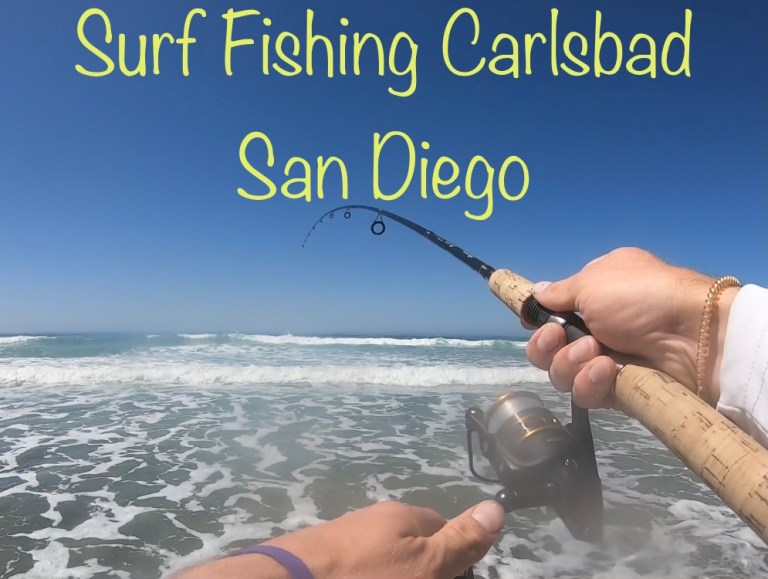
What Does a Bite Feel Like In the Surf?
Anyways, while you may have been or still are discouraged about surf fishing because you hadn’t or haven’t caught anything yet, trust me here. Nothing will give you more confidence than feeling your first bite and landing your first fish. And I’ll be honest, sometimes when I try a new bait out, I feel like I have to start over again and regain the confidence. Confidence is absolutely key! If you don’t have confidence, your chances of catching fish are diminished drastically.
A bite will feel like this: “da… da-da…..da………………..da-da-da-da!” It’s not until you feel that last portion of the bite that you should actually set the hook. If all you feel is, “da……..da-da………da….” leave your bait there and patiently keep tension awaiting the real bite. The fish is likely nibbling away or timidly testing your bait. Maybe it did already take and it’s either too small to really do a full-take, or it has yet to move. In either case, I believe it’s always better to be patient and set slightly late than to set early. Granted, it’s much better to time it perfectly.
When you finally feel that, “da-da-da-da” (3 or more times in a row) and I like to say, “you feel the weight of the fish”; once you feel that, that’s when you set the hook. A nice solid wrist and elbow hook set is all you need. The biggest, most important two things to keep in mind are tension and being concise. If you’re going to set the hook, do it with confidence and zero hesitation. You’d be better off not setting the hook at all than doing a half-ass hookset. Set the hook, and set it with confidence.
How to Fight a Fish in the Surf
Once you commit to your hook set, it’s again about keeping good tension. So, wait for the right moment, give it a nice, concise hookset, and keep tension. As soon as you set that hook, you’re letting the fish dictate the fight, while responding by matching it’s every move. If it wants to run, keep the rod pointed in its direction and let it run with the drag set appropriately. If it gives a little bit, take a little bit, but be ready for its next run and be prepared to let it run again. The moment the fish pulls, if you either pull too hard or give too much slack you’re giving it an opportunity to spit the hook.
Refrain from multiple hook sets and sporadic rod movement or inconsistent rod positioning. One concise hook set is enough. If you didn’t like the way your hookset felt, it’s too late to rip into it again, so just keep good tension. “Setting” the hook multiple times simply will not help. No sporadic movements! I know you’re excited! But try to keep your cool and be smooth with your rod, if your jerking the rod up and down or left and right while the fish is trying to do the same, you’re creating infinite moments of excessive slack to excessive tension. Each time, creating a moment for either the fish to spit the hook, or for you to rip the hook from its mouth.
Beaching a Fish
After some time, you’ll come to realize what’s necessary for which fish, but generally, if you hook something of decent size, you’ll want to “beach” it. Sure, some fish are small enough that you can reel them in and simply lift them out of the water, but it’s good practice (especially with bigger fish) to beach them properly. As it gets closer in to shore, you want to use the surf to your advantage.
This will come naturally if you fight the fish based on matching its movements. When a wave moves in over the fish, it’ll likely “give” a little bit. This is when you use the momentum of the wave to help in fighting the fish. But, many times the fish will sense this and take off! In this case, don’t force it, remain calm and let the fish run until it gives you another opportunity. Keep responding to the fish’s movements and the momentum of the waves and eventually, you’ll have an opportunity to beach the fish. For the best chances of not losing your fish, wait for an opportunity for the waves to help you “wash” your fish ashore.
Eating Fish from the Surf?
If you’re fish is of legal and ethical keeping size, great! Keep it and make the most of the meat it provides. I’m a big supporter of conservation and I’d always recommend only keeping what you need. Realistically, I don’t see “keeping limits” as necessary or completely ethical, but I understand that for some people, it’s needed and if it’s legal it’s legal. I practice about 96% catch and release, and if I’m not going to be eating either the night of or the next day (maybe the next two days), I’m not going to keep. At the end of the day, that’s just my opinion and how I operate.
I don’t want to come off as someone who is “against” keeping fish because that’s not the case. I absolutely enjoy it and I think there’s a romanticism about eating your catch and even feeding the family with your catch. In fact, to that point, here’s my page on some of my go-to recipes for cooking fish from So Cal's surf. But, do some research on the fish you do keep. Learn about its breeding habits and tendencies for being overfished etc.
Surf Fishing Forecast
It looks like the warmer water is here to stay and I wouldn’t expect any more major drops at least within the next week. Our water temp is holding steady around 62-64 degrees Fahrenheit which is just on the brink of where the summertime bite really gains traction. Any moment has potential right now for a really good day.
The surf appears to be gradually calming down, but it’s still relatively high in some areas with overall large swells and far-out rollers. I think at this point, these winter-like high rollers are what’s kept the bite from really going off. None the less, it’s been a decent bite with perch still active and croaker and corbina starting to round the corner. This time of year, anything is fair game.
My latest video of the San Diego Beaches series is up on YouTube, and if you haven’t watch my video of the tanker spotfin I caught sight casting, I highly recommend giving that a look. Toward the middle and end of the video, you start to see what I mean by active feeding fish in the shallows. I think it’s so awesome looking stuff! So Click the image link below.
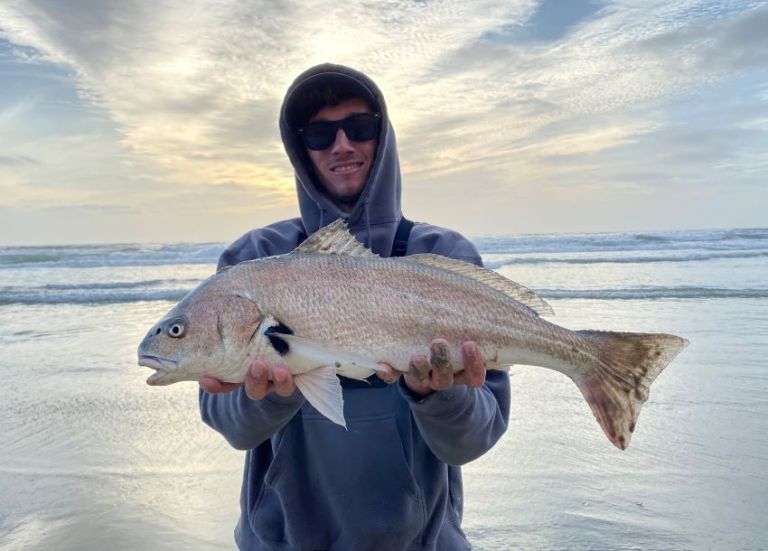
This essay from: https://surffishingsocalsd.com/how-to-go-surf-fishing/

























